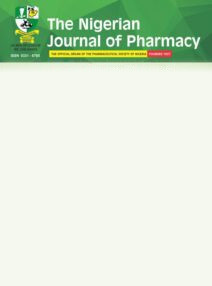Quality Assessment Of Some Brands Of Co-Trimoxazole Suspensions Available In Ilorin, Nigeria
Keywords:
Chemical analysis, Microbiological analysis, Co-trimoxazole, IlorinAbstract
Background: Fake and substandard drugs are becoming serious area of concern in our society. These drugs have led to therapeutic failure, adverse effects and microbial resistance to drugs. Therefore, there is the need for routine quality assessment of these drugs in the market to ascertain that they are stable, efficacious and safe for consumption.
Objective: This work was aimed at carrying out chemical and microbiological analysis on eleven brands of Co-trimoxazole suspensions sold in Ilorin, Kwara state and comparing results with a brand used as secondary standard using t-test analysis.
Methods: Chemical analysis was done using titrimetric methods to determine the percentage contents of the active components of the various samples of Co-trimoxazole suspension. Microbiological analysis was done using pour plate method to determine bacteria and fungi counts of samples. Analysis was done using SPSS computer software and p values less or equal 0.05 were considered statistically significant.
Results: One brand of the Co-trimoxazole suspension failed the chemical test using USP, 2006 specification with average trimethoprim content of 88.94 ± 0% while three brands failed using BP, 2013 specification. Two of these brands had sulfamethoxazole average contents of 109.19 ± 0.72% and 107.85 ± 0% in addition to the brand that failed the USP, 2006 specification. Sample t-test analysis showed that majority of samples varied significantly from sample used as standard.
Conclusion: Generally, over 70% of the various brands of Co-trimoxazole samples examined complied with official standards.
References
Muhammed TL (2008). The limits of legal and enforcement/ regulatory frameworks in consumer protection against counterfeit and pirated products: the Nigerian experience. [Paper presentation at 4th Global conference on Counterfeit and Pirated products].
All countries (2008). Counterfeit Medicines. Available at: http://www.allcountries.org/health/counterfeit_medicines.html [Accessed 20 March 2014].
Ilisa BGB (2012). FDA Efforts: Counterfeit drugs [Paper presentation at APhA Annual meeting, New Orleans].
Lybecker KM (2007). Rx Roulette: Combating Counterfeit Pharmaceuticals in Developing Nations. Managerial and Decision Economics, 28: 509-520.
Silverman MM, Lydecker M and Lee PR (1990). The drug swindlers. International Journal of Health Services, 20: 561–572.
Erhun WO, Babalola OO, Erhun MO (2001). Drug regulation and control in Nigeria: The Challenge of Counterfeit drugs. Journal of Health and Population in developing countries, 4(2): 23-34.
Ohuabunwa, M (2002). Health care delivery in Nigeria. Past Present and the future. Nigerian Journal of Pharmacy, 31: 15-17.
Mehta V (2006). Global threat of Counterfeit Drugs. A Study covering Extent of Problem and Anti-counterfeit Measures in Europe and India. Available at http://www.pharma.unibonn.de/www/dra/metha [Accessed on 30 March 2014].
Erah PO, Olumide GO and Okhamafe AO (2003). Prescribing practices in two health care facilities in Warri, Southern Nigeria: A comparative study. Tropical Journal of Pharmaceutical Research, 2(1): 175-182.
Akande TM and Ologe MO (2007). Prescription pattern at a Secondary health care facility in Ilorin, Nigeria. Annals of African Medicine, 6(4): 186-189.
Enato EFO and Chima IE (2011). Evaluation of drug utilization patterns and patient care practices. West African Journal of Pharmacy, 22(1): 36-41.
Abu-Saeed K, Joseph GS and Joseph FL (2013). Prescription pattern of antibiotics among physicians in a secondary health facility in Abuja, Nigeria. British Journal of Pharmaceutical Research, 3(4): 940-947.
Martindale: The complete drug reference (2011). 37th edition. Sean CS (ed). USA: Pharmaceutical press: 280-282.
Emdex (2013). The complete drug formulary for Nigeria’s health professionals. Canada: Chris 5ive consulting Inc.: 359.
British Pharmacopeia (2013). 7th edition, Vallender M (ed). London: The Stationery Office: 2754-2755.
Sethi PD (2008). Quantitative analysis of drugs in Pharmaceutical formulations, 3rd edition. India: CBS publishers and distributor: 569.
Nigeria Custom Services (2014) Import prohibition list. Available at https://www.customs.gov.ng/ProhibitionList/import.php [Accessed on 29 May 2014].
United States Pharmacopeia and National Formulary (2006). USP-29-NF24; The United States Pharmacopeia convention Inc.: 4786.
Calistus DN, Uduma EO, Ogechukwu CO, Christian CO and Christopher EN (2011). Microbial and Physicochemical qualities of selected co-trimoxazole and metronidazole formulations in South Eastern Nigeria. Journal of Advanced Pharmacy Education and Research, 2: 81-89.
Kasim LS, Awoyemi AA, Coker HAB, Adepoju-Bello AA and Aziba PI (2012). Chemical evaluation of Sulfamethoxazole in some brands of co-trimoxazole tablets. Journal of Pharmaceutical Research and Opinion, 2(7): 66-69.

Downloads
Views | PDF Downloads:
322
/ 303


